Dynamic Soil Structure Interaction of a High-Rise Building Resting over a Finned Pile Mat
Abstract
1. Introduction
2. Materials and Methods
2.1. Structural Design
2.2. Material Properties
2.3. Three-Dimensional FEM Modeling
3. Numerical Analysis Program
4. Analysis of the Regular Pile-Mat
5. Analysis of the Finned Pile-Mat
5.1. Time–History Plots
5.2. Effect of Fin-Length on the Seismic Response of the Structure
5.2.1. Variation in Peak Acceleration
5.2.2. Variation in Peak Horizontal Displacement
5.2.3. Variation in Inter-Story Drift
6. Conclusions
- The maximum peak acceleration and maximum horizontal displacement of the high-rise building supported by piled mats does not drastically increase as we move towards the top story. Instead, it shows stiffer behavior in a particular story (Story-10 in the present study), and variation after that remains almost linear.
- The provision of fins in the piled mats drastically reduces detrimental vibrations due to earthquakes. Finned piles, with a fin-length (Lf) of just 0.2Lp, can reduce the seismic response of high-rise buildings by more than 98%.
- The fin-length (Lf) has a high level of influence over the effect of the seismic response, (i.e., regarding FP-Mats, as the fin-lengths increase, the variation between inter-story drift readings remains constant (i.e., stiffer behavior) in subsequent stories). It is responsible for reducing story displacements due to seismic loading.
- FP-Mats with fin-lengths (Lf) of 0.6Lp and 0.8Lp showed nearly identical horizontal displacement variation; hence, considering the seismic performance and economical construction, 0.6Lp may be considered the optimum fin-length for reducing the seismic response.
- Compared with the RP-Mat, the using FP-Mats during the construction of high-rise buildings can reduce horizontal displacement by 1.7 × 109, 8.2 × 109, 4.3 × 1010, and 5.5 × 1010 times for FP-Mats with fin-lengths of 0.2Lp, 0.4Lp, 0.6Lp, and 0.8Lp, respectively.
- The drifting bounds of the FP-Mat system were reduced by increasing the fin-lengths (i.e., the difference between the maximum and minimum inter-story drift was found to be 0.115% for the RP-Mats, and for FP-Mats with fin-lengths of 0.2Lp, 0.4Lp, 0.6Lp, and 0.8Lp, the differences were 6.57 × 10−11%, 1.23 × 10−11%, 3.0 × 10−12%, and 2.6 × 10−12%, respectively). Hence, this drastically reduces the average rotation between the beam and column within same story.
Author Contributions
Funding
Data Availability Statement
Acknowledgments
Conflicts of Interest
References
- Kramer, S.L. Geotechnical Earthquake Engineering; Pearson Education India: Noida, India, 1996. [Google Scholar]
- Fatahi, B.; Tabatabaiefar, H.R.; Samali, B. Performance Based Assessment of Dynamic Soil-Structure Interaction Effects on Seismic Response of Building Frames. In GeoRisk 2011; American Society of Civil Engineers: Reston, VA, USA, 2011; pp. 344–351. [Google Scholar] [CrossRef]
- Wolf, J.P.; Obernhuber, P. Non-linear soil-structure-interaction analysis using dynamic stiffness or flexibility of soil in the time domain. Earthq. Eng. Struct. Dyn. 1985, 13, 195–212. [Google Scholar] [CrossRef]
- Anand, V.; Satish Kumar, S.R. Seismic Soil-structure Interaction: A State-of-the-Art Review. Structures 2018, 16, 317–326. [Google Scholar] [CrossRef]
- Guin, J.; Banerjee, P.K. Coupled Soil-Pile-Structure Interaction Analysis under Seismic Excitation. J. Struct. Eng. 1998, 124, 434–444. [Google Scholar] [CrossRef]
- Tabatabaiefar, H.R. Determining Seismic Response of Mid-Rise Building Frames Considering Dynamic Soil-Structure Interaction. Ph.D. Thesis, University of Technology Sydney, Sydney, Australia, 2012. [Google Scholar]
- Tabatabaiefar, H.R.; Clifton, T. Significance of Considering Soil-Structure Interaction Effects on Seismic Design of Unbraced Building Frames Resting on Soft Soils. Aust. Geomech. J. 2016, 51, 55–64. [Google Scholar]
- Zhang, X.; Far, H. Effects of dynamic soil-structure interaction on seismic behaviour of high-rise buildings. Bull. Earthq. Eng. 2022, 20, 3443–3467. [Google Scholar] [CrossRef]
- Peng, J.R. Behaviour of Finned Piles in Sand under Lateral Loading. Ph.D. Thesis, University of Newcastle, Newcastle upon Tyne, UK, 2005. [Google Scholar]
- Peng, J.; Rouainia, M.; Clarke, B.G.; Allan, P.; Irvine, J. Lateral Resistance of Finned Piles Established from Model Tests. In Proceedings of the International Conference on Geotechnical Engineering, Universite Libanaise, Beirut, Lebanon, 13 April 2004; pp. 565–571, ISSN 9953-0-0252-5. [Google Scholar]
- Nasr, A.M.A. Experimental and theoretical studies of laterally loaded finned piles in sand. Can. Geotech. J. 2014, 51, 381–393. [Google Scholar] [CrossRef]
- Bariker, P.; Rajesh, K.S.; Raju, K.V.S.B. A study on lateral resistance of finned piles in sands. In Advances in Offshore Geotechnics, Lecture Notes in Civil Engineering; Haldar, S., Patra, S., Ghanekar, R., Eds.; Springer: Singapore, 2020; Volume 92, pp. 319–336. [Google Scholar]
- Ambi, R.; Jayasree, P.K.; Unnikrishnan, N. Study of fin shape on the behaviour of finned piles under combined loading conditions. In Proceedings of the IOP Conference Series: Earth and Environmental Science, Kerala, India, 11–13 December 2020; Volume 491. [Google Scholar] [CrossRef]
- Yaghobi, M.H.; Hanaei, F.; Fazel Mojtahedi, S.F.; Rezaee, M. Numerical finite element analysis of laterally loaded fin pile in sandy soil. Innov. Infrastruct. Solut. 2019, 4, 14. [Google Scholar] [CrossRef]
- Babu, K.V.; Viswanadham, B.V.S. Numerical Investigations on Lateral Load Response of Fin Piles. In Sustainable Civil Infrastructures; Shehata, H.R.Y., Ed.; Springer: Cham, Switzerland, 2018; pp. 317–329. [Google Scholar] [CrossRef]
- Babu, K.V.; Viswanadham, B.V.S. Numerical studies on lateral load response of fin piles. Geomech. Geoengin. 2019, 14, 85–98. [Google Scholar] [CrossRef]
- Ambi, R.; Ambi, R.; Unnikrishnan, N. Effect of fin shape on the behaviour of piles under combined loading conditions. In Recent Advances in Materials, Mechanics and Management; Sheela Evangeline, M.R., Rajkumar, S.G.P., Eds.; CRC Press: London, UK, 2019; pp. 44–48. [Google Scholar] [CrossRef]
- IS 456; Plain and Reinforced Concrete—Code of Practice [CED 2: Cement and Concrete]. 4th ed. Bureau of Indian Standards: New Dehli, India, 2000.
- Bariker, P.; Kolathayar, S. Appraisal of Innovative Finned-Pile Foundations to Resist Lateral Loads. In Ground Characterization and Foundations, Lecture Notes in Civil Engineering; Satyanarayana Reddy, C.N.V., Muthukkumaran, K., Sathyam, N., Vaidya, R., Eds.; Springer: Singapore, 2022; pp. 697–707. [Google Scholar]
- Peng, J.R.; Rouainia, M.; Clarke, B.G. Finite element analysis of laterally loaded fin piles. Comput. Struct. 2010, 88, 1239–1247. [Google Scholar] [CrossRef]
- Albusoda, B.S. Experimental Study on Performance of Laterally Loaded Plumb. J. Eng. 2017, 23, 9. [Google Scholar]
- Albusoda, B.S.; Al-Saadi, A.F.; Jasim, A.F. An experimental study and numerical modeling of laterally loaded regular and finned pile foundations in sandy soils. Comput. Geotech. 2018, 102, 102–110. [Google Scholar] [CrossRef]
- Peng, J.; Clarke, B.G.; Rouainia, M. Increasing the Resistance of Piles Subject to Cyclic Lateral Loading. J. Geotech. Geoenviron. Eng. 2011, 137, 977–982. [Google Scholar] [CrossRef]
- CSI Computers and Structures INC. CSI Analysis Reference Manual, 18th ed.; CSI: Berkeley, CA, USA, 2017. [Google Scholar]
- IS 1893-1; Criteria for Earthquake Resistant Design of Structures, Part 1: General Provisions and Buildings [CED 39: Earthquake Engineering]. 6th ed. Bureau of Indian Standards: New Dehli, India, 2016; Volume 1893.
- PEER Ground Motion Database. Available online: https://ngawest2.berkeley.edu/ (accessed on 15 September 2022).
- SP 36 (Part1); Compendium of Indian Standards on Soil Engineering: Part-1 LaboratoryTesting of Soils for civil Engineering Purposes [CED 43: Soil and Foundation Engineering] (Reaffirmed 2006). Bureau of Indian Standards (BIS): New Delhi, India, 1987; p. 110002.
- ASTM D-2487-17e1; Standard Practice for Classification of Soils for Engineering Purposes (Unified Soil Classification System). ASTM: West Conshohocken, PA, USA, 2017.
- Abaqus, Version 6.21; Dassault Systèmes SIMULIA Corporation: 6.21: Woodbury, MN, USA; Dassault Systèmes: Singapore, 2021.
- Park, D.; Hashash, Y.M.A. Soil damping formulation in nonlinear time domain site response analysis. J. Earthq. Eng. 2004, 8, 249–274. [Google Scholar] [CrossRef]
- Van Nguyen, Q.; Fatahi, B.; Hokmabadi, A.S. Influence of Size and Load-Bearing Mechanism of Piles on Seismic Performance of Buildings Considering Soil–Pile–Structure Interaction. Int. J. Geomech. 2017, 17, 1–22. [Google Scholar] [CrossRef]
- Kim, Y.; Jeong, S.; Lee, S. Wedge Failure Analysis of Soil Resistance on Laterally Loaded Piles in Clay. J. Geotech. Geoenviron. Eng. 2011, 137, 678–694. [Google Scholar] [CrossRef]
- Fatahi, B.; Basack, S.; Ryan, P.; Zhou, W.-H.; Khabbaz, H. Performance of laterally loaded piles considering soil and interface parameters. Geomech. Eng. 2014, 7, 495–524. [Google Scholar] [CrossRef]
- Belinchon, P.; Sørensen, K.K.; Christensen, R. Finite element investigation of the interaction between a pile and a soft soil focussing on negative skin friction. In Proceedings of the 17th NordicGeotechnical Meeting, Reykjavik, Iceland, 25–28 May 2016; pp. 513–522. [Google Scholar]
- Han, Y. Seismic Response of Tall Building Considering Soil-Pile-Structure Interaction. Earthq. Eng. Eng. Vib. 2002, 1, 57–64. [Google Scholar] [CrossRef]
- Galal, K.; Naimi, M. Effect of Soil Conditions on the Response of Reinforced Concrete Tall Structures to Near-Fault Earthquakes. Struct. Des. Tall Spec. Build. 2008, 17, 541–562. [Google Scholar] [CrossRef]
- Bilotta, E.; Sanctis, L.D.; Di Laora, R.; D’Onofrio, A.; Silvestri, F. Importance of Seismic Site Response and Soil–Structure Interaction in Dynamic Behaviour of a Tall Building. Géotechnique 2015, 65, 391–400. [Google Scholar] [CrossRef]
- Bagheri, M.; Jamkhaneh, M.E.; Samali, B. Effect of Seismic Soil–Pile–Structure Interaction on Mid- and High-Rise Steel Buildings Resting on a Group of Pile Foundations. Int. J. Geomech. 2018, 18, 1–27. [Google Scholar] [CrossRef]
- Scarfone, R.; Morigi, M.; Conti, R. Assessment of Dynamic Soil-Structure Interaction Effects for Tall Buildings: A 3D Numerical Approach. Soil Dyn. Earthq. Eng. 2020, 128, 105864. [Google Scholar] [CrossRef]
- Arboleda-Monsalve, L.G.; Mercado, J.A.; Terzic, V.; Mackie, K.R. Soil–Structure Interaction Effects on Seismic Performance and Earthquake-Induced Losses in Tall Buildings. J. Geotech. Geoenviron. Eng. 2020, 146, 1–14. [Google Scholar] [CrossRef]
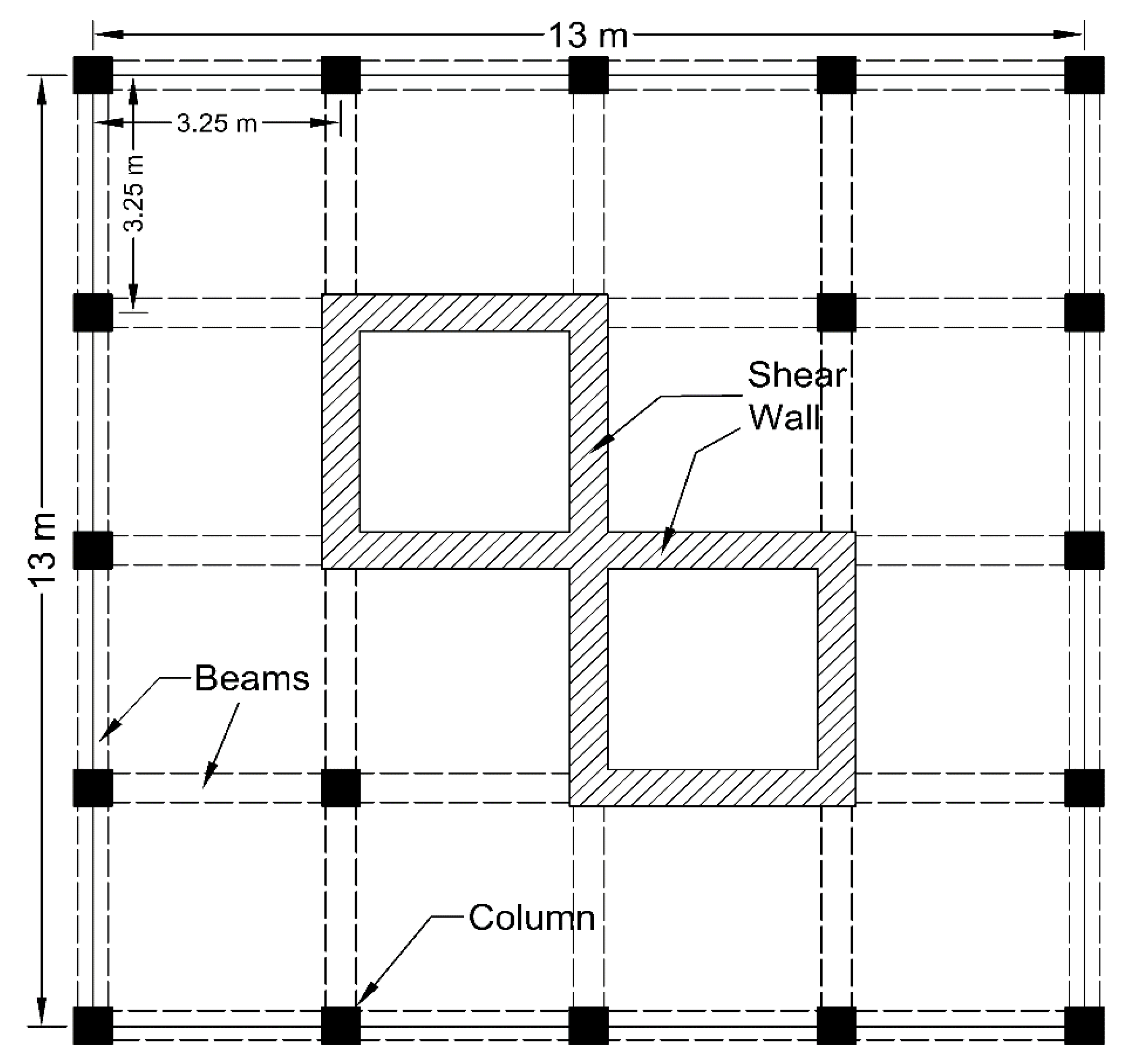

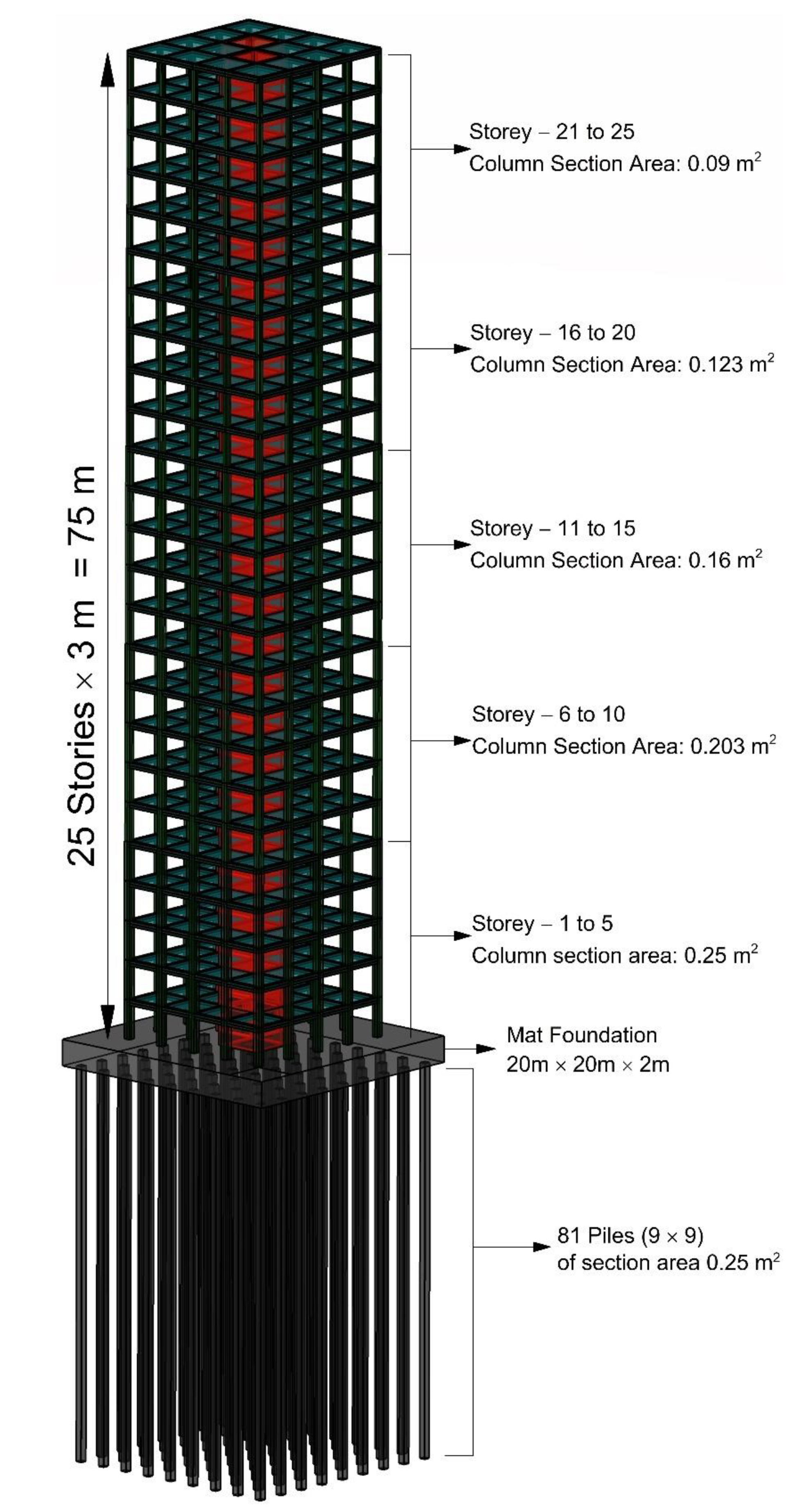


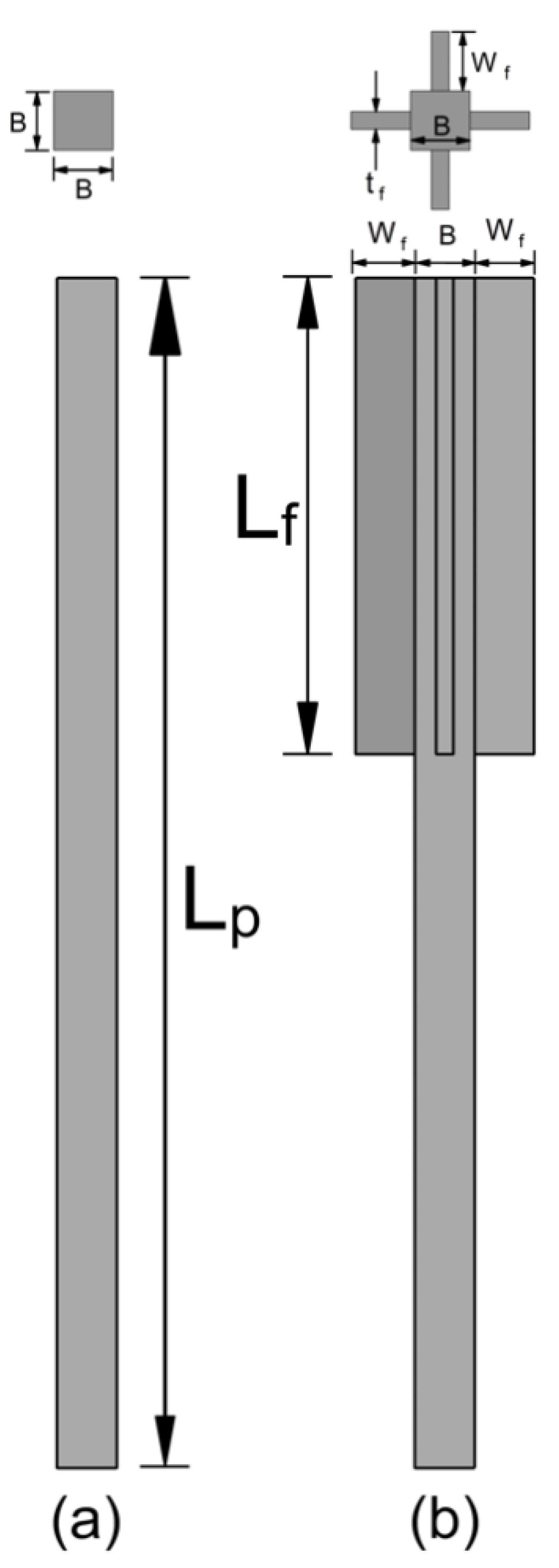
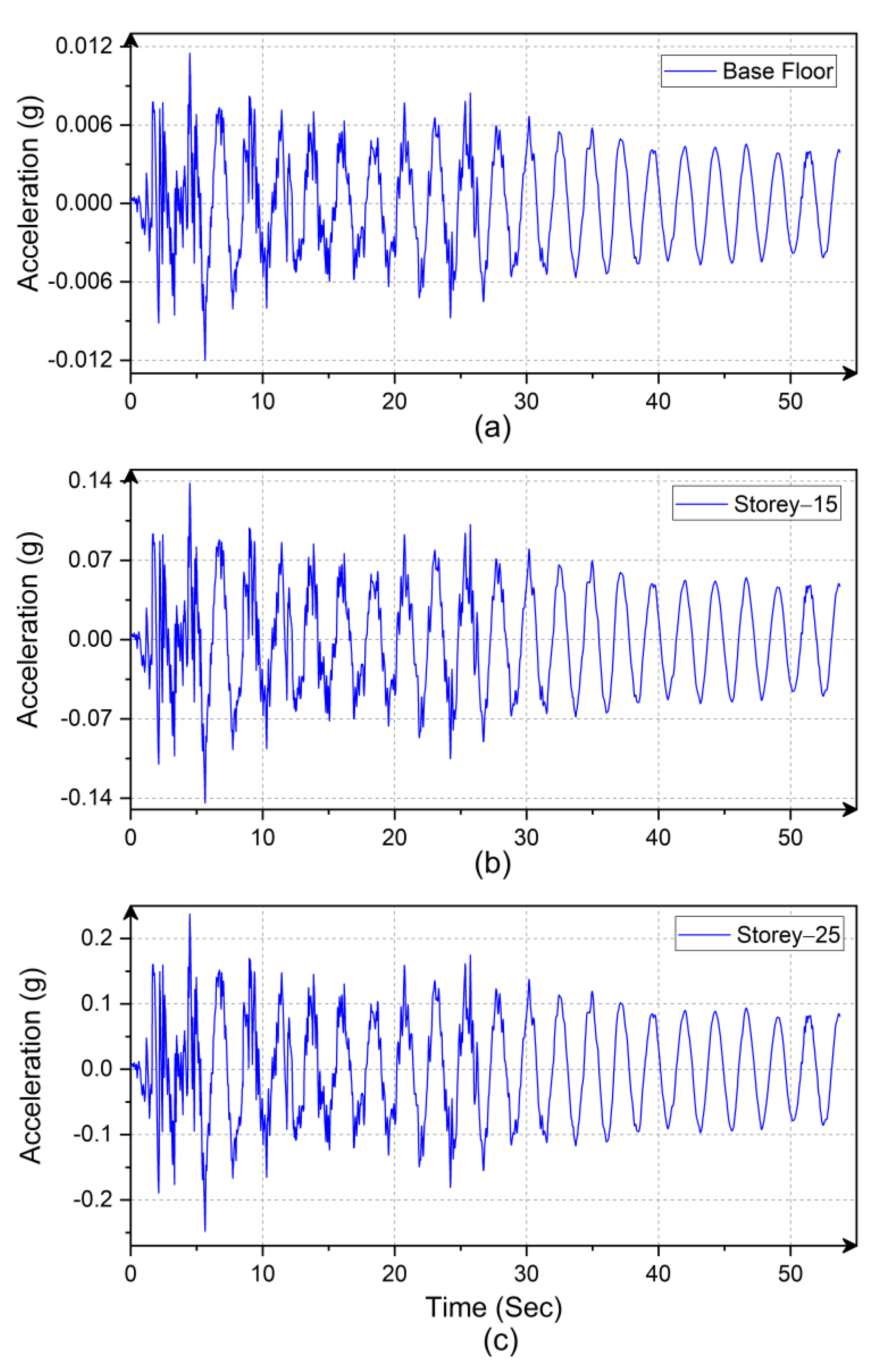

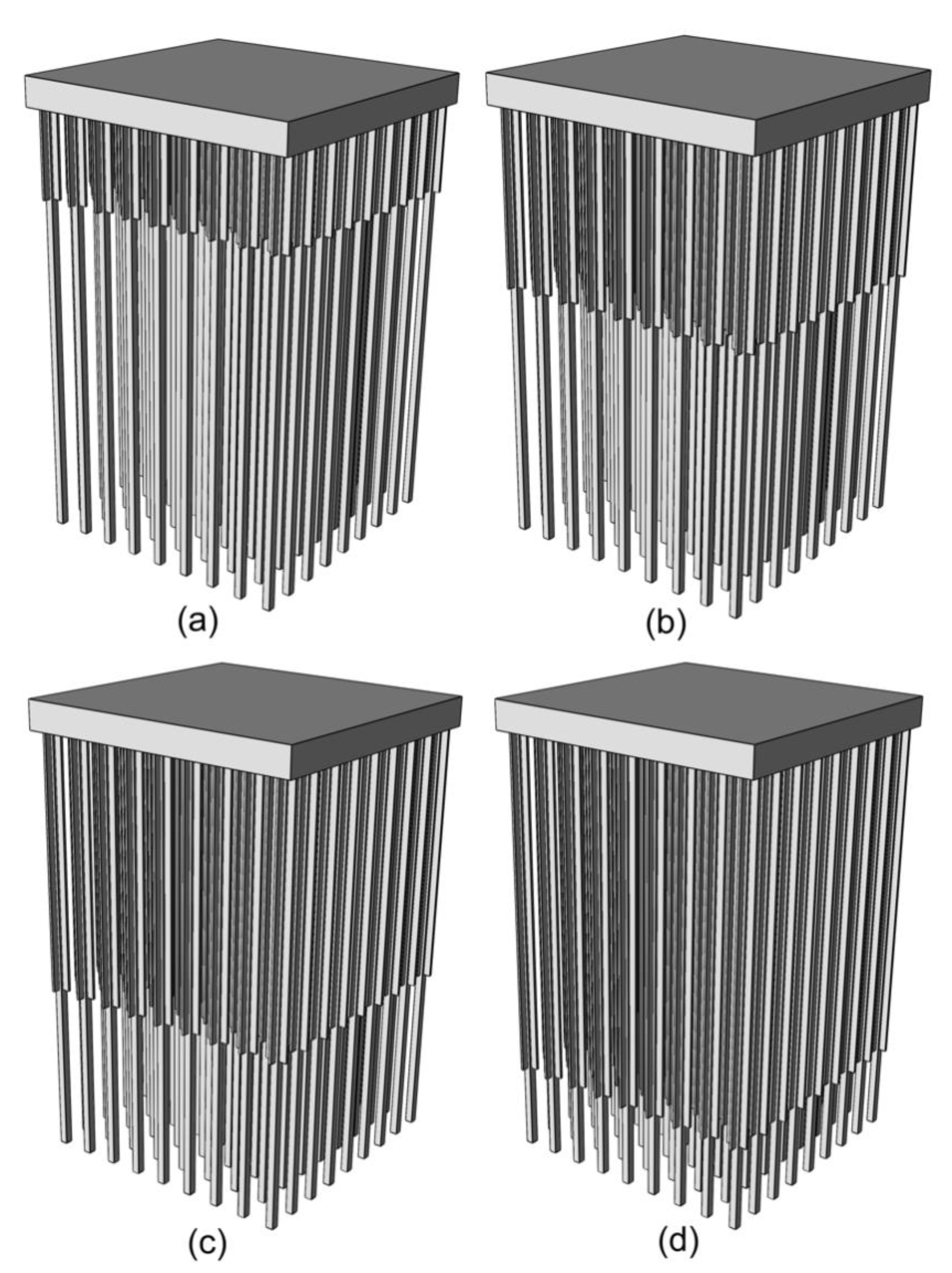

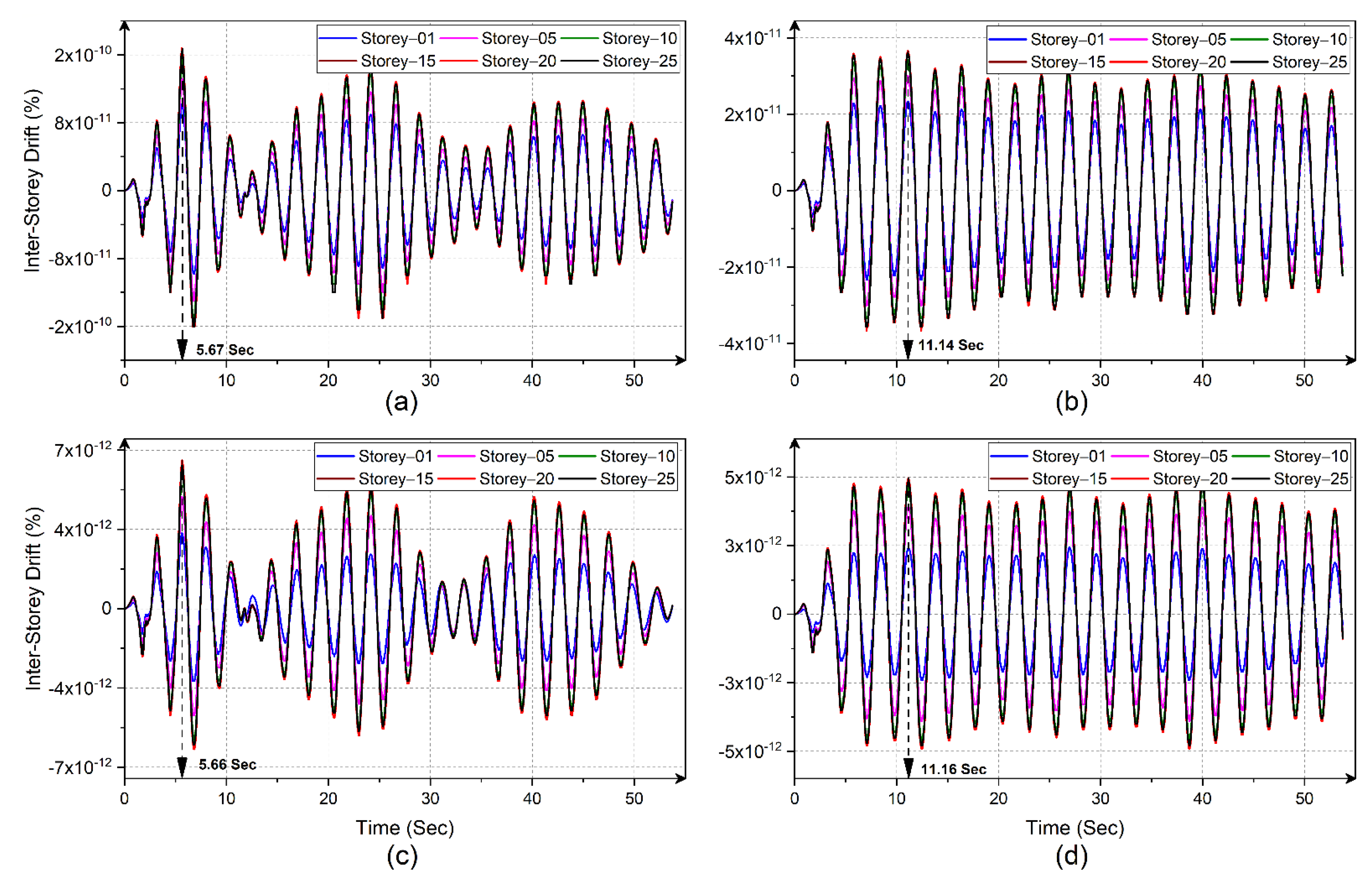

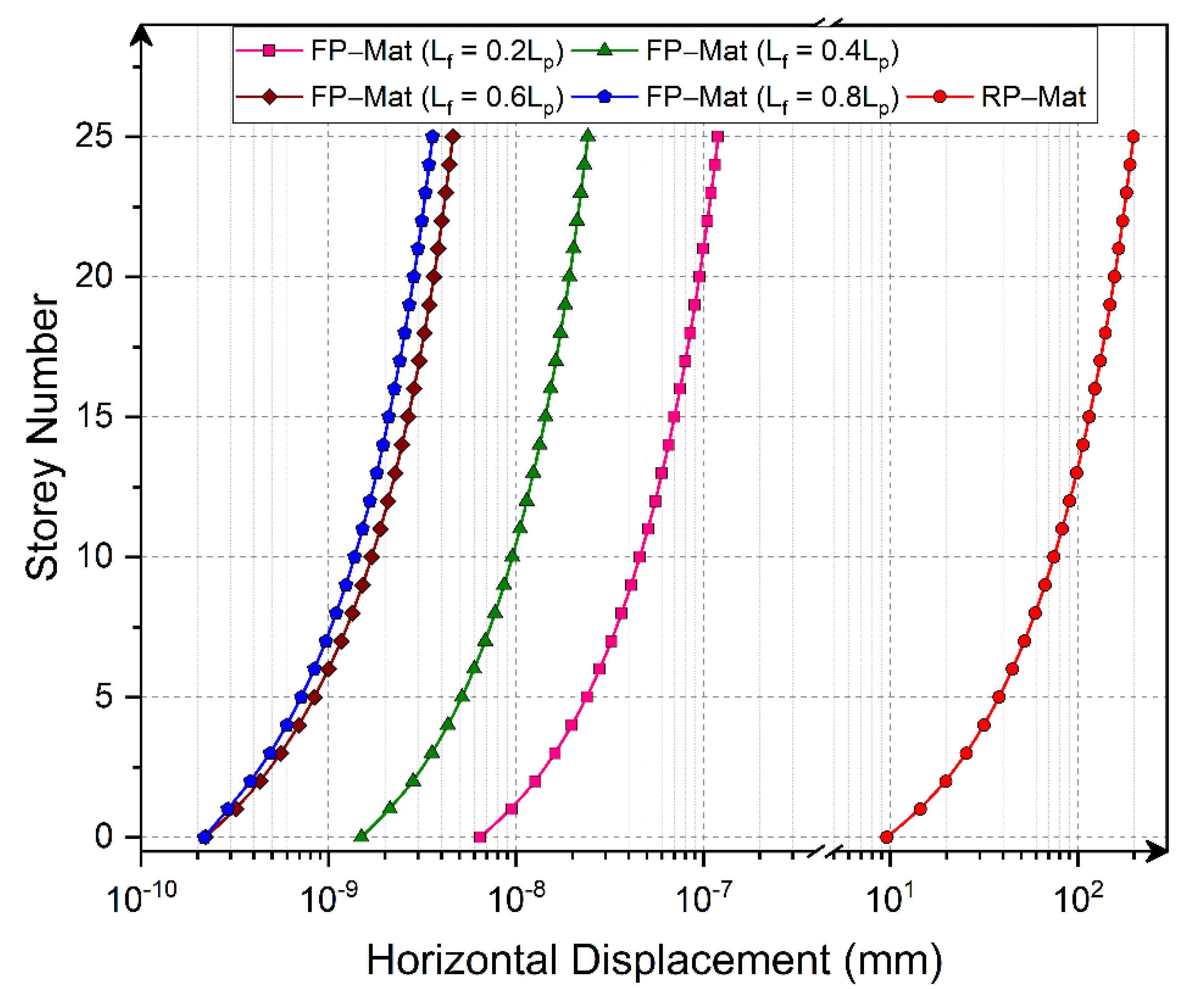

| Section Type | Column-1 | Column-2 | Column-3 | Column-4 | Column-5 | Shear Wall | Slab | Beam |
|---|---|---|---|---|---|---|---|---|
| Story-level | 1 to 5 | 6 to 10 | 11 to 15 | 16 to 20 | 21 to 25 | 1 to 25 | 1 to 25 | 1 to 25 |
| Dimensions (m) | 0.5 × 0.5 | 0.45 × 0.45 | 0.4 × 0.4 | 0.35 × 0.35 | 0.3 × 0.3 | 0.5 m thick | 0.25 m thick | 0.3 × 0.4 |
| Cross section area (m2) | 0.25 | 0.2025 | 0.16 | 0.1225 | 0.09 | 0.5 (per m width) | 0.25 (per m width) | 0.12 |
| Longitudinal Reinforcement (N#bar, mm) | 12#24 | 12#24 | 12#24 | 12#20 | 12#20 | #12@150 | #16@250 | 3#12 (Top) 4#16 (Bot.) |
| Tie reinforcement (#bar@spac, mm) | #10@75 | #10@125 | #10@180 | #10@200 | #10@225 | #10@200 | -- | #10@180 |
| Characteristic Properties | Soil | Structural Elements |
|---|---|---|
| Material model | Mohr–Coulomb Model | Visco-elastic Model |
| Unit Weight, γ (kN/m3) | 15.5 | 25 |
| (kg/m3) | 1580 | 2548 |
| Young’s Modulus, E (MPa) | 28 | 29,580 |
| Poisson’s ratio, ν | 0.33 | 0.2 |
| Friction angle, ϕ (°) | 22 | -- |
| Dilatancy angle, ψ (°) | 1 | -- |
| Cohesion, c (kPa) | 24 | -- |
| Void ratio, e | 0.882 | -- |
| Permeability, K (m/s) | 4.8 × 10−9 | -- |
| Series | Description | Constant Parameters | Varying Parameters |
|---|---|---|---|
| I | Regular Pile-Raft (RP-Raft) | Piles: Lp = 30 m, size = 0.5 m × 0.5 m Mat: 2 m thick, size = 20 m × 20 m | -- |
| II | Finned Pile-Raft (FP-Mat) | Fin-Length (Lf/Lp) of 0.2, 0.4, 0.6, and 0.8 |
Publisher’s Note: MDPI stays neutral with regard to jurisdictional claims in published maps and institutional affiliations. |
© 2022 by the authors. Licensee MDPI, Basel, Switzerland. This article is an open access article distributed under the terms and conditions of the Creative Commons Attribution (CC BY) license (https://creativecommons.org/licenses/by/4.0/).
Share and Cite
Bariker, P.; Kolathayar, S. Dynamic Soil Structure Interaction of a High-Rise Building Resting over a Finned Pile Mat. Infrastructures 2022, 7, 142. https://doi.org/10.3390/infrastructures7100142
Bariker P, Kolathayar S. Dynamic Soil Structure Interaction of a High-Rise Building Resting over a Finned Pile Mat. Infrastructures. 2022; 7(10):142. https://doi.org/10.3390/infrastructures7100142
Chicago/Turabian StyleBariker, Pankaj, and Sreevalsa Kolathayar. 2022. "Dynamic Soil Structure Interaction of a High-Rise Building Resting over a Finned Pile Mat" Infrastructures 7, no. 10: 142. https://doi.org/10.3390/infrastructures7100142
APA StyleBariker, P., & Kolathayar, S. (2022). Dynamic Soil Structure Interaction of a High-Rise Building Resting over a Finned Pile Mat. Infrastructures, 7(10), 142. https://doi.org/10.3390/infrastructures7100142







